Reptile & Amphibian
News Blog
Keep up with news and features of interest to the reptile and amphibian community on the kingsnake.com blog. We cover breaking stories from the mainstream and scientific media, user-submitted photos and videos, and feature articles and photos by Jeff Barringer, Richard Bartlett, and other herpetologists and herpetoculturists.
Thursday, March 30 2017
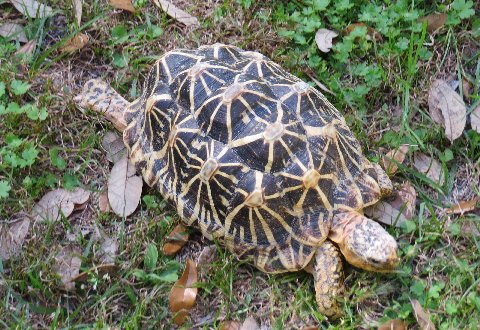
Searching for just the right spot.
Earlier in the day it rained just enough to dampen the ground. No matter the relatively insignificant rainfall, the moisture WAS significant to a female Indian star tortoise. She deemed it nesting time. She had begun coursing the entire enclosure at about the time the 3rd droplet had
fallen. And she continued until an hour later when she had chosen a site that she felt satisfactory. The site chosen was a grassy area between 2 small woody shrubs. She began the nesting process at 1:30 PM and continued preparation through a heavy rain that filled the in-process nest and a temperature drop (from 83F to 65F) until 4:00 PM. Egg deposition and refilling took another hour and a half.
As soon as the female had completed the nesting sequence, Patti redug the cavity with “egg-theft” in mind. In traditional fashion the neck of the nest was long and of small diameter while the egg-site was larger and easily contained the 5 eggs. Interestingly the female, showing more dedication than many do, had not only ignored the temporarily flooded conditions of the nest and the resulting “mudpie” but had encountered and worked around a large horizontal root as well. It took Patti about 15 minutes of careful manipulation to remove the eggs.
The eggs are now in the incubator and I’ll let you know the results in about 3 months. Wish us luck.
Continue reading " Indian Star Tortoise Nesting Dedication"
Monday, March 27 2017
By
Mon, March 27 2017 at 15:47
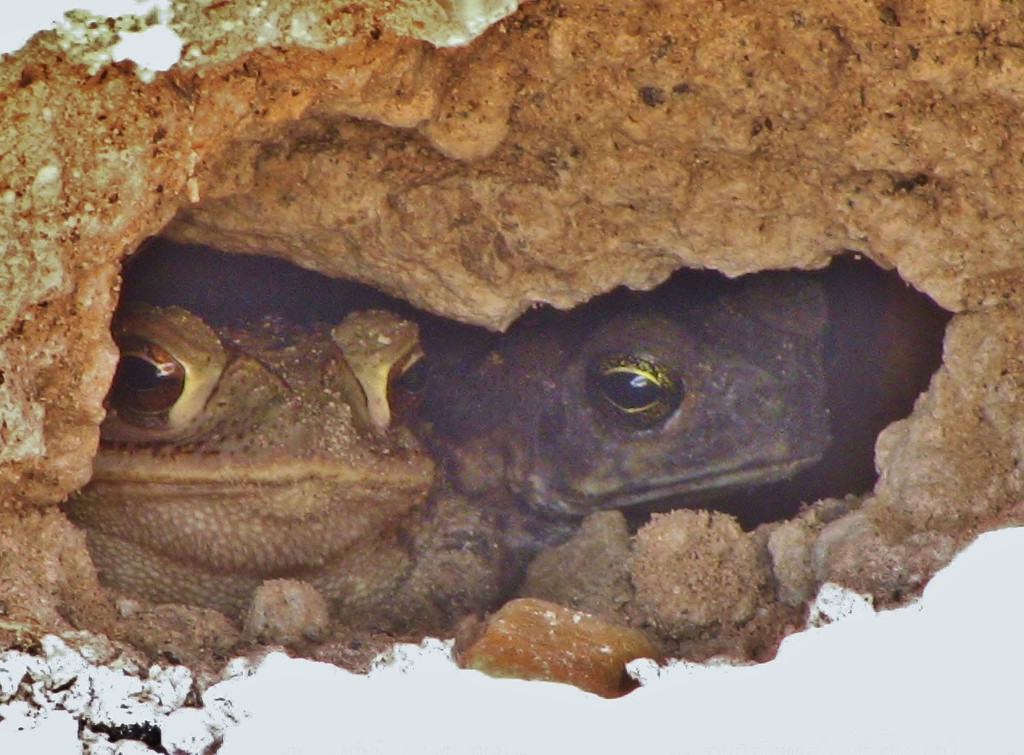
Cane Toad and Gulf Coast Toad co-inhabiting in the same burrowThe Deep South Texas terrain is quite interesting. It’s mostly a delta with none to very little elevation. Hence the features of the terrain are mostly thorn-scrub, at least what is still sort of intact. The rest has become ag-land for crops or urban sprawl. The point being that there are no rock cuts, or boulders or hills or other features that are conducive to providing herps a lot of hiding spaces. As a result they’re often found around people’s houses using artificial cover.
There was one incidence when I observed a Cane Toad and a Gulf Coast Toad co-inhabiting in the same burrow. It made me wonder why they’d do so if the Cane Toad could potentially poison the gulf coast toad or even eat it. I looked around the caliche pit and there weren’t very many hiding spaces, as is the case for most of the Lower Rio Grande Valley. So, my curiosity was overwhelming and I wanted to see who was being choosy about the burrow availability.
I collected 30 Cane Toads and 30 Gulf Coast toads. With the help of a NASA engineer we designed a box with identical burrows, except one was connected to a cooler and maintained a cool 75 degrees, while the rest of the chamber was brought up to 100°F, not unusual for the region. This caused the other burrows to maintain a temperature about 10-15 degrees lower than ambient temperature, but the cooled burrow remained at 75°F. We put in pairs of toads of the same species, or one of each species all for 10 minutes at a time, never using the same toad twice during one trial. We had infrared cameras set up to look inside the burrows and digital cams above recording their movements.
We found that Gulf Coast Toads will enter any hole they can inhabit to escape the heat, but Cane Toads, explored all available holes and 90% of the time chose the cool burrow. The other 10 percent of the time they chose burrows that already had a toad inside. We presented this work at the Joint Meeting for Ichthyologists and Herpetologists. The reason for this I believe is that by being in close proximity to another toad they reduce surface area and hence decrease desiccation. Another advantage is that if the “other” toad expels some water onto the substrate both the Cane Toad and the Gulf Coast toad can re-uptake it. Cane toads were sort of using the other toads as living canteens if you will, because they’re just bad-asses and excellent problem solvers.
Thursday, March 23 2017
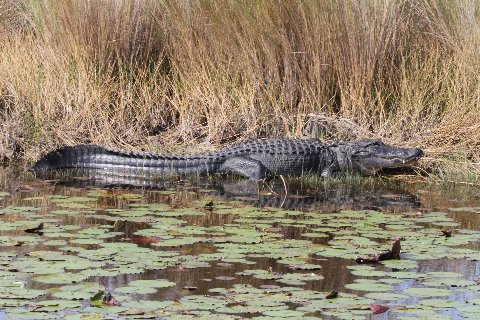
American alligator, very dark, broad snout
“Dick LOOK.”
I was in the shotgun seat and my vision to the water on the driver’s side was obscured.
Not realizing this Dan exclaimed again, but not as emphatically. “Look.” By then he had swung the car around and there on the boat launch ramp lay a 6 ½ foot long American crocodile, Crocodylus acutus.
This wasn’t really unexpected, for we were in the Everglades National Park, but unexpected or not, seeing a croc, by far the rarer of the 2 native American species, is always exciting.
Actually it was the second one of the day but rather than being out in the open as this one was, the first had been basking in the evening sunlight beneath a doc and was largely covered by floating water plants.
Besides our 2 native species, Florida is home to a 3rd crocodilian species. This the introduced spectacled caiman, Caiman crocodilus ssp., has been present in rather small numbers for more than 50 years. It is restricted to southern FL.
Individuals of at least 3 other crocodilian species have been found in FL. These have been the smooth-fronted caiman, the black caiman, a Nile crocodile, and a croc that, despite DNA samples having been assessed, defies identification.
Florida’s native and established crocodilians: On all, the markings are usually most prominent when the animal is wet.
American alligator: hatchlings and juveniles are black with yellow crossbands. Adults are black. Snout broad and rounded. To 19 feet but usually 12 feet or less.
Spectacled caiman: hatchlings and juveniles are olive green, olive yellow, or olive brown with darker bands, Adults are usually dark olive gray, Snout moderately broad. A bony ridge across snout just anterior to eyes. To 8 feet but usually 6 feet or less.
American crocodile: hatchlings and juveniles are greenish gray with broken darker crossbands that are often most prominent dorsally. Adults are (usually dark) grayish green. Snout long, narrow, and tapering. To 15 feet but usually less than 12 feet.
Continue reading "The American Crocodile"
Wednesday, March 22 2017
By
Wed, March 22 2017 at 20:25
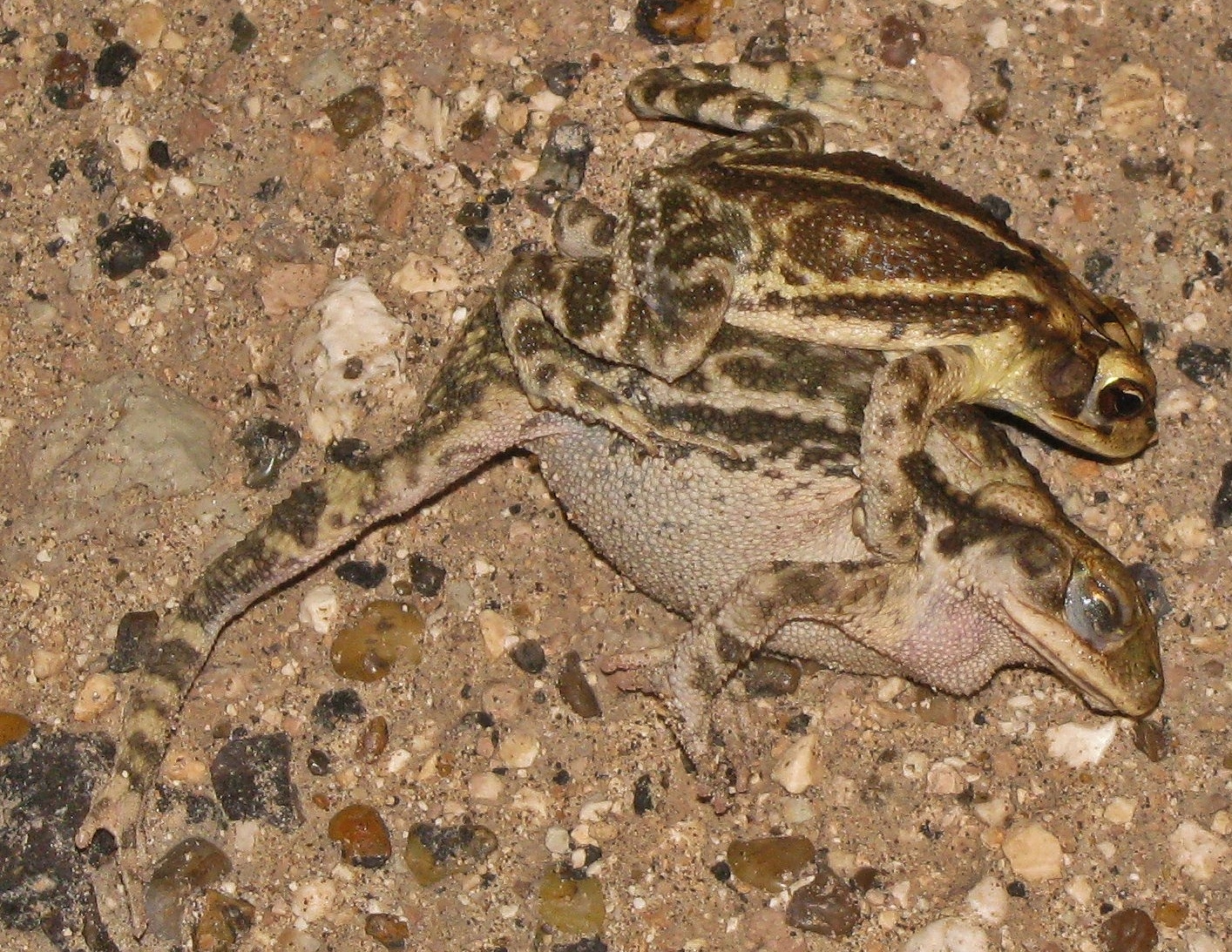
Amplexed Gulf Coast ToadsIn evolutionary biology we always discuss animal’s basic needs and instinctual behaviors used to satisfy these needs. The Four F’s (fleeing, fighting, feeding, and well reproduction), are great drivers of some of the extreme or even awkward behaviors we sometimes see in nature. “Gotta do what you gotta do right?”
One day back in May of 2010 I was road cruising and a ton of rain had just fallen, the roads were thick with amphibians of all kinds. I drove down a dirt road on which both of the sides of the roads were flooded by ephemeral pools of water. The calls of Sheep Frogs ( Hypopachus variolosus), Narrow-mouth Toads ( Gastrophryne olivacea), Cane Toads ( Rhinella marina), Couch’s Spadefoots ( Scaphiopus couchii) and Gulf Coast Toads ( Incilius nebulifer) among some were so loud the chorusing was deafening.
Shortly into my drive I found a very strange little scenario going on. Right next to the roadside ephemeral pool I noticed a pair of amplexed Gulf Coast Toads. Around the pair, like the scene out of some strange ritual, were 3-4 other male toads standing close by just watching, as if waiting for their turn. Well in fact, it turns out they probably were! They seemed to be acting out what would typically occur had they been just a few inches further in the actual water body. When a male and female amplex, satellite males sneak nearby trying to fertilize some of the eggs to pass on their own genetics. In this case they were just outside the water body.
However, what was the big deal with the deal female, how could that even work right? Well back in 2012 (Izzo et al. J. Nat. Hist. 46:47–48) observed similar behavior playing out. They termed it “functional necrophilia” in which even when the female is already dead, the male is able to massage the still viable eggs, out of her fresh body and fertilize them. Thereby, benefiting both individuals including the dead female, as her genes also get passed on along with his own.
The instinct of the fourth F, ‘reproduction,’ is a strong one. I guess one can relate, right? Nevertheless, we reported the first case of necrophilia in Incilius nebulifer in the journal Herpetological Review (2013, 44:4 pp. 655-656).
The force is strong with the four Fs! Of course since then (and prior to this publication) we’ve learned of necrophilia in lizards, snakes, other anurans, and it likely occurs in other taxa as well, and if we haven’t reported it, we’ll stumble upon it eventually. How successful the strategy is among other vertebrates is still a topic of discussion, but at least with some anurans we know it works!
As for the creepy satellite males standing by on watch, well, they’re just going to have to keep watching until the amplexed male works his magic massage!
Tuesday, March 21 2017
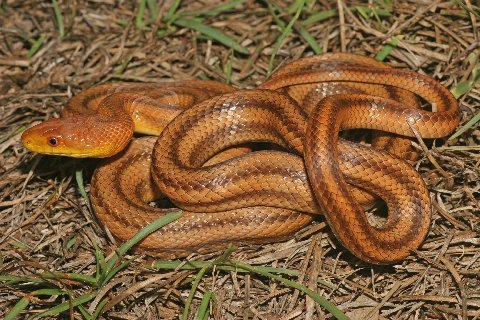
This pretty yellow rat snake is from southcentral Florida.
Although the range of the yellow rat snake, Pantherophis obsoletus quadrivittatus, extends far north of FL, let’s just take a quick look at some of the color variations of this pretty constrictor in the Sunshine State. Generally speaking, the snake is least colorful (olive yellow) in northcentral FL and most richly hued (bright yellow) in seFL. The keywords in the last sentence are “generally speaking” for variations within any geographic area are not only possible but should be expected.
Just as the ground color varies from north to south, so, too, does the color, thickness, and intensity, of the four dark stripes that provide the alternate name of “four-lined rat snake” for this subspecies. The stripes may be black, brown, buff, or orange. Thickest and darkest in ncFL, the lines may be well defined or barely visible in central FL and very poorly defined in the seFL. But again, let me emphasize, variation is the rule of thumb. One of the prettiest and most precisely striped yellow rat snakes I have seen in recent times has been from Polk County—right on the heart of the peninsula.
And now that I’m thinking about yellows, I guess I’ll head to Polk County in the AM!
Continue reading "The Variable Yellow Rat Snake"
Thursday, March 16 2017
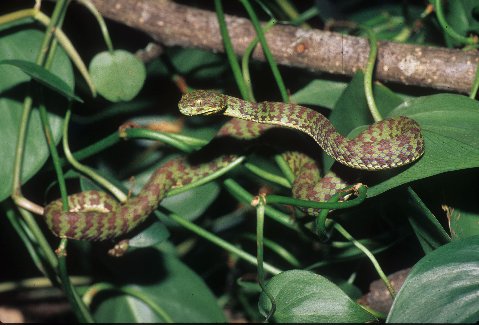
This is an adult female T. venustus.
In a group often thought to consist of, or at least to be dominated by, green arboreals, the little Trimeresurus venustus is, indeed, a beautiful species with a difference. It is as often referred to by the common name of “brown spotted tree viper,” as by the more appropriate “beautiful tee viper. The former name does not do justice to the snake (that was for decades confused with the Kanburian tree viper, T. kanburiensis, and is actually a brown on brown snake) for the spots are more often a dull red or maroon than brown and more often than consisting of isolated spots, the spots coalesce into a pattern consisting of partial or complete side-to-side bars.
Once a rarity, T. venustus is now rather readily available in the pet trade. Native to Thailand, this rather slender viper occasionally attains a length of 32 inches but most adults seen are between 26 and 30 inches long.
Reportedly being primarily terrestrial in the wild, those I have had and other captives I have seen have been quite arboreal. Prey in the wild is said to consist primarily of anurans and lizards. Captive of all sizes usually readily accept suitably sized mice, including those that have been thawed and warmed.
Continue reading "Beautiful Tree Viper"
Wednesday, March 15 2017
By
Wed, March 15 2017 at 10:34
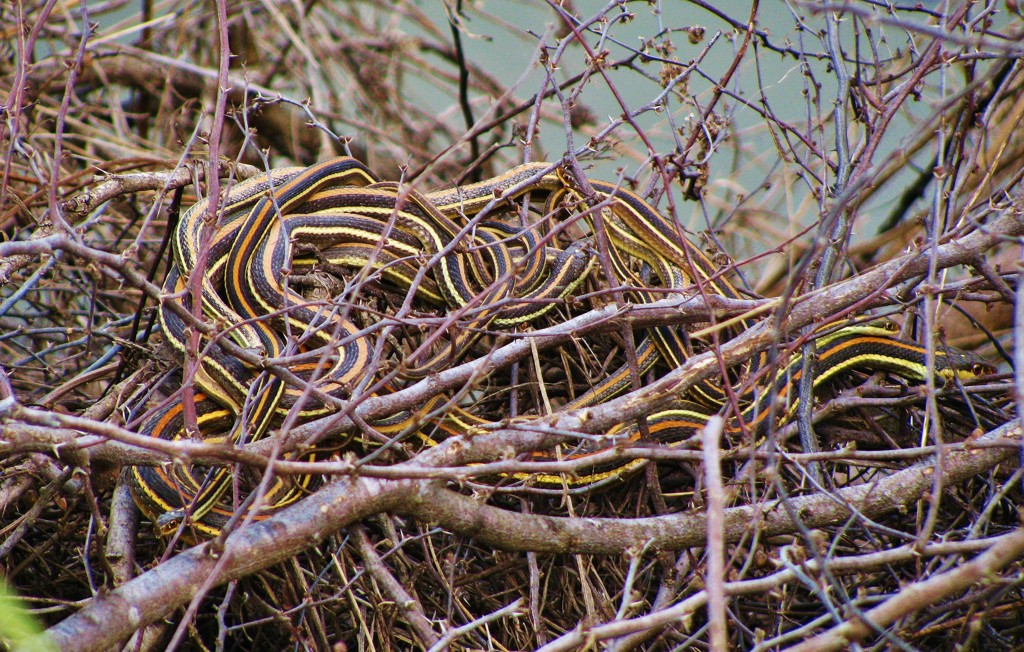
Gulf Coast Ribbon Snake (Thamnophis proximus orarius) mating ball in January (winter) displaying stage III courtship behaviorm
In the previous blog we discussed how snakes’ breeding behavior is different in the Lower Rio Grande Valley (LRGV), and gave an example of the case of Leptodeira septentrionalis, Northern Cat-Eyed Snake, an attractive species unique to this region. Although the literature says they’re spring breeders, it seems that our field observations contradict that.
An even more drastic example of snakes that breed without brumating in the LRGV are Gulf Coast Ribbon Snakes ( Thamnophis proximus orarius), they too, are supposed to breed during the spring. One day back in 2010 I was hiking through a small refuge and noticed a rather small mating ball consisting of about 8 snakes. This occurred in January, still winter, and the snakes were in full courtship behavior. Over the next few days I continued to observe them around the same “denning” site, which consisted only of a dense pile of branches. I documented this behavior and published it as the earliest reproducing snake in the country (Oyervides and Zaidan, 2014. Herp.Rev. 45(1):574). Over the course of the next few years I continued to monitor the behavior of this species in this region.
I’ve now learned that they breed year round. One would think that this would be detrimental to the snakes and they’d likely breed themselves to death in an effort to put out as many litters as possible, but it seems that’s not the case. Neonate and gravid Ribbon Snakes can be found year round in this region. In conducting my field surveys of these, I’ve also located a record size Ribbon snake, and one with a record size litter. Thus if they’re growing this large, having multiple litters per year doesn’t seem to be detrimental to them.
Their breeding behavior is also quite contrary to what the literature says, mind you, that last update on their biology was back in the 50’s by Tinkle. There is a very marked dimorphism between males and females of the species. When a female is being courted, she has several small males around her. These will follow her around and shadow her every move. Unlike in large mating balls where the males stress the females so much they practically force them into copulation, here, the female decides when she’s ready, as the males are too small to force her to do anything. These satellite males as I call them, will follow her around for days or weeks until she’s ready. Upon copulating, the males will disperse, and she will spend a lot more time up on tree branches absorbing as much sunshine as she can to speed up the process of having her first litter of the year and prepare for the next.
The advantage to this behavior is that because of the warm climate, there is a food supply for neonates year round. Moreover, their population numbers really decrease during years of drought. Having such a high number of individuals ensures that at least some will survive the droughts and restore a healthy population as soon as conditions improve. It’s amazing how sometimes we know so little of some of the most common species around!
Female with a male where the sexual dimorphism is evident.

Tuesday, March 14 2017
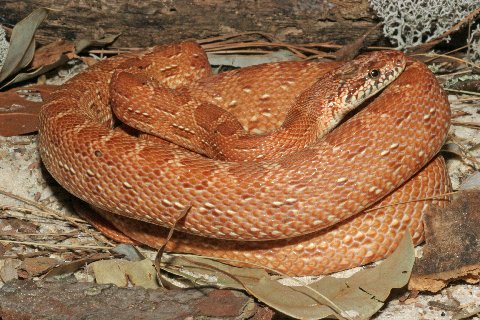
Not all royal diadem snakes are strongly patterned.
For reasons still unbeknownst to me, the snakes of the genus Spalerosophis have never become overly popular with hobbyists. Big, hefty, easy to care for, attractive. and relatively inexpensive — even though they are a bit on the feisty side and an opisthoglyph, it seems to me that at least one species, S. diadema atriceps, should have become a hobby wide favorite.
Let’s address the opisthoglyphid aspect first. Clinical toxinology assessments on this snake by the University of Adelaide conclude: “Bites by this species are not expected to cause medically significant effects and the only risk, probably small, is local secondary infection. Patients presenting with bites by these snakes do not require medical attention, other than to check for infection and ensure tetanus immune status. ”The report continues “Non-venomous, so essentially all bites should be “dry.”
In other words, despite its enlarged rear teeth and feisty attitude, this snake is considered nonvenomous.
Over the years the royal diadem snake (also known as the black headed diadem snake, or simply, diadem rat snake) has been bred by a few dedicated hobbyists. Hopefully there will continue to be enough interest in this species to assure that this big orange on orange snake doesn’t disappear from the hobby.
Continue reading "Royal Diadem Snake"
Monday, March 13 2017
By
Mon, March 13 2017 at 15:01
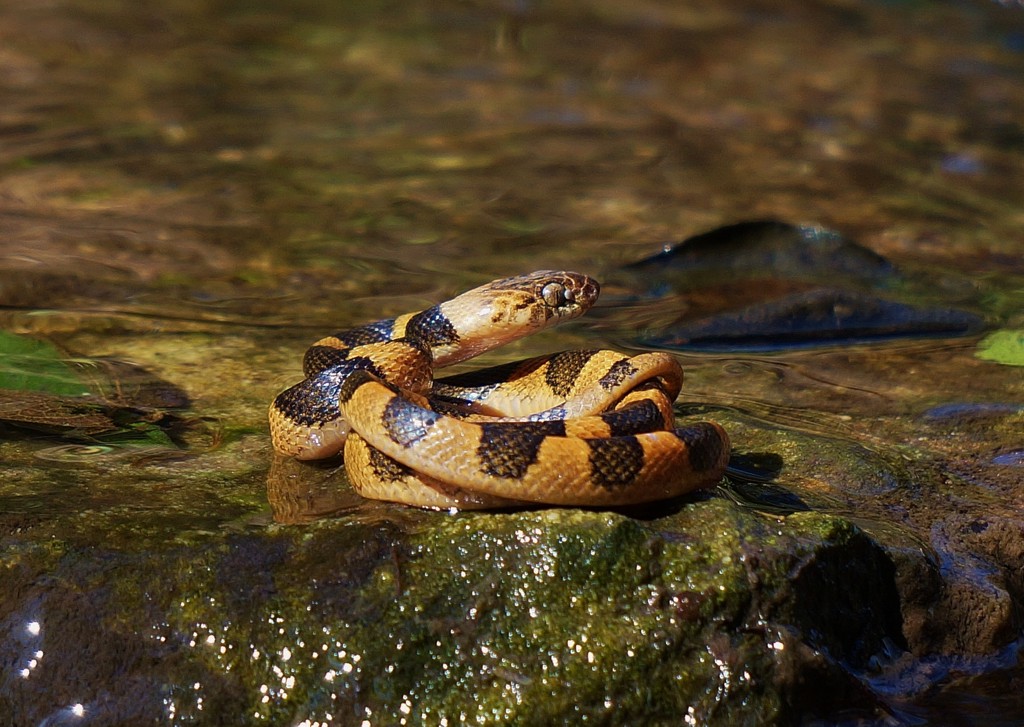
Northern-Cat Eyed Snake Leptodeira septentrionalis
The southernmost region of the Lone Star State is a very interesting location. It harbors several unique species only found here, as this is their northernmost range from either Mexico or Central America. With its dry subtropical clime, most of the year is hot and winters are extremely mild. The vegetation (or what’s left of it), consists of some succulent plants that extend through the sandsheet, thornscrub forests and chaparral.
In over a decade that I’ve been conducting research here, I’ve noticed that for many species, winters aren’t cold enough and certainly not prolonged enough to result in any significant brumation period. A lack of brumation time, interestingly, may result is several species here reproducing year round or producing multiple clutches in a year (this is a neat discussion topic).
For example, one very attractive species found only in this part of the country is the Northern-Cat Eyed Snake ( Leptodeira septentrionalis). Relatively little is known about their natural history in this part of their range. We currently have ongoing projects with the species to learn more about their secretive lifestyle.
One observation I’ve made so far is that there are active neonates in December and January, and gravid females in September. This suggests the species is either double clutching or are fall breeders instead of spring breeders as the literature denotes (at least in this part of their range). Even without extended brumation periods, it seems in some parts of their distribution their populations remain stable, while in others they are facing environmental pressure due to habitat loss. I’ve noticed the peak of their activity is during temperatures in the mid 60s to mid 70s. They are rear-fanged and will feed on anurans, lizards, other snakes, and even mice. Finding neonates that late, (or early), in the year, poses more questions than answers for me. I guess we still have a lot more to learn about this enigmatic species.
Thursday, March 9 2017
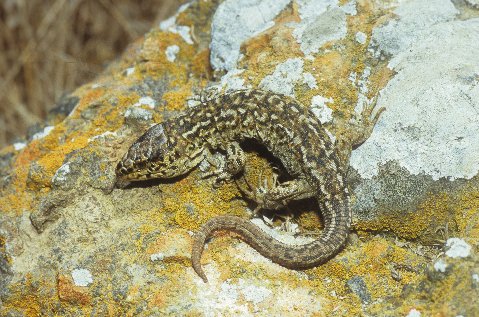
Although a night lizard, this island taxon may be active diurnally.
We were traveling to Santa Barbara Island in California’s Channel Island group specifically to see the large, mostly diurnal, Island night lizard, Xantusia riversiana reticulata. A dichotomy? Diurnal night lizard? Indeed it seemed so and we hoped that this taxon was as diurnal as we had been told.
We were aboard a comfortable catamaran belonging to Island Packers in Ventura, CA. On the trip out we saw more common dolphins than we had known existed, a blue whale, and many pelagic birds. About 3 hours after we had left we arrived, to be greeted by elephant seals, California sea lions, and a US Fish and Wildlife Service agent, the latter who explained the dos and the don’ts associated with our visit. Then up a steep incline, hoping to avoid the depredations of the common ravens that are so adept at ferreting out stored foods and trinkets, and then ambling slowly up the footpath in search of the lizard that had drawn us...
The Island night lizard was the last of the 8 US species in the genus that we needed to photograph for our western turtles and lizards field guide. And once we were on its home real estate of the 8” long (that’s HUGE for a night lizard, by the way) lizard we quickly learned that the word “night” in its name really was a misnomer. We were to see and photograph the stocky, brown reticulated grayish, omnivorous, lizards, basking and foraging on and around many of the rocks along the trail. Some, their lidless eyes all watching for ravens, were even scrounging for crumbs beneath the picnic tables.
If you are ever out that way, check out the Channel Islands. It is an experience you will long remember.
Continue reading " Island Night Lizard"
Wednesday, March 8 2017
By
Wed, March 8 2017 at 00:10
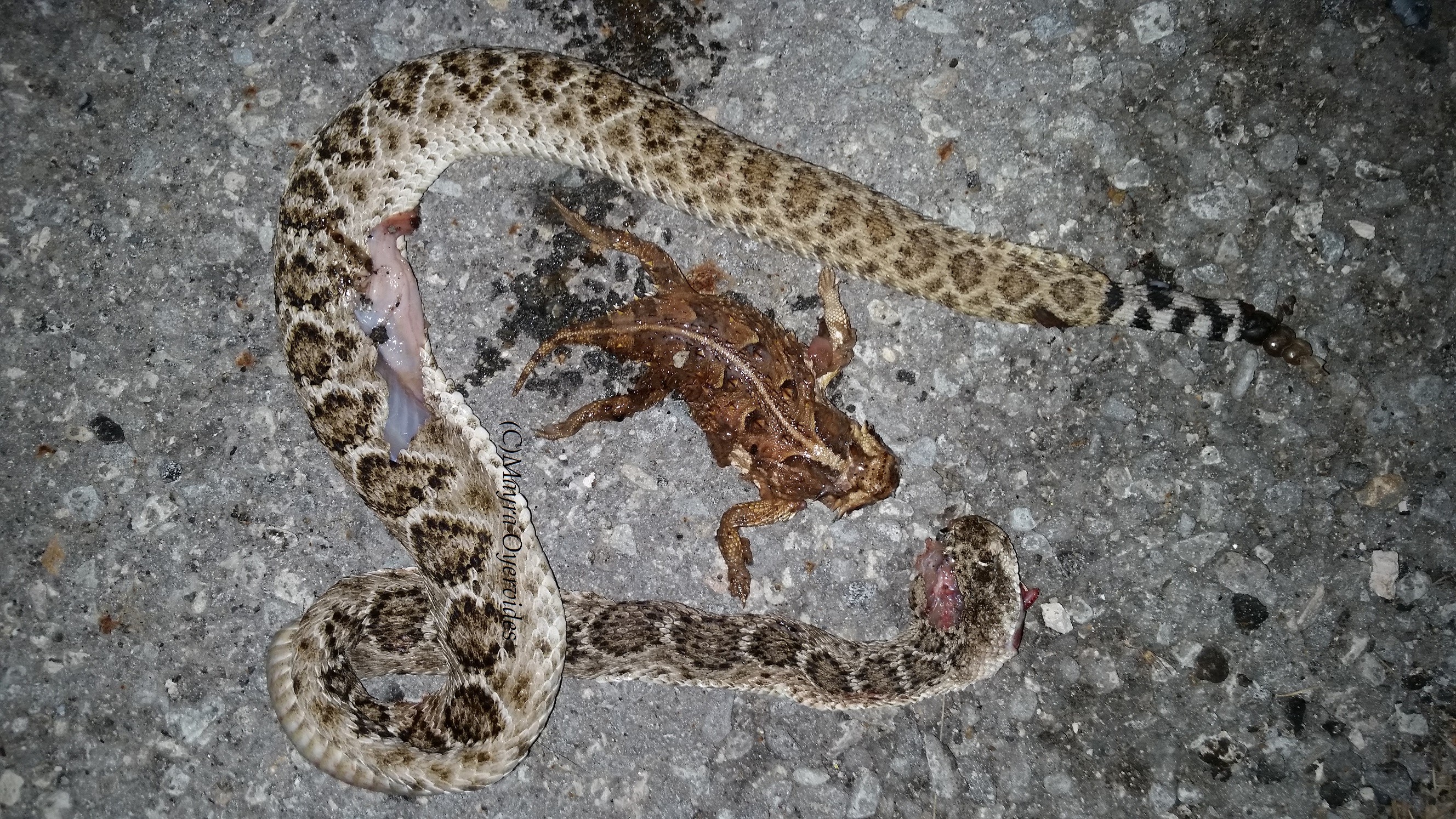
This Western Diamondback's, Crotalus atrox, last meal was a Texas horned lizard, Phrynosoma cornutum
If you’re a herper that wants to make an everlasting contribution to science. What better way than by providing information that end users such as yourself or researchers can turn into valuable scientific data. Collecting either tissues or whole vouchers from DORs isn’t typically what the vast majority of herpers do. But we should! In doing so we are supplying immeasurable amounts of information that can be used for current research on snakes and amphibians, but also for a hundred years in the future! Through the use of vouchers, (preserved specimens curated in a collection), we can learn many things about species’ such as their anatomy and physiology, their diets, morphological variation and so much more.
Loving herps means doing all we can to aid in our understanding of their natural histories, their conservation, and population trends. With the advent of apps such as iNaturalist and HerpMapper (and others), we’re capable of recording digital (sounds, video, images) of sightings of live animals more than ever. This in turn illustrates that the range for many species or their numbers are much more expansive than previously thought. If you’re interested in citizen science start collecting DORs and submitting your digital vouchers.
But after you do, what’s next? In most cases you can call a local university and ask if they have a vertebrate collection. Once you find a museum, explain what you do and what you collect, in most cases curators will help you get vouchers to them. Some may even provide basic essentials, such as notebooks for data pertaining to the vouchers you’re providing. If a museum is not in your area, most will facilitate shipping to them. For tissue samples most curators would happily provide tubes.
So the next time you find a dead snake, a skull, snake skeleton etc. pick it up! The way I see it, we’re already out there, rather than letting those DORs become dry jerky on the road let’s make an everlasting impact and start publishing your findings so we all may learn!
Tuesday, March 7 2017

Mountain skinks are one of the most beautiful members of the genus.
At an adult length of 6 to 7 inches, the beautiful mountain skink, Plestiodon callicephalus, is a denizen of habitats that vary from rocky desert to wooded slopes. Those that I have seen have been along the rocky banks of seasonal creeks, and with just a little effort on the part of the searcher, the rocky banks of one spring-fed water trough could always be depended on to harbor at least one of these skinks.
This taxon has a light “Y” shaped marking on the top of the head, a fawn dorsum, and a broad dark stripe on each side. The stripe narrows posteriorly and fades entirely a few scale rows posterior to the hind limbs.
Like many skinks, the mountain species has a brilliant blue tail when young. Unlike many other skink species that lose the blue with growth and age, the mountain skink retains the blue throughout its life but the intensity dulls some with age.
Primarily a Mexican species, in the USA the mountain skink occurs only in extreme scAZ and the western bootheel of NM. From there it ranges southward to the vicinity of Guadalajara, MX.
Continue reading "Mountain Skink"
Monday, March 6 2017
By
Mon, March 6 2017 at 00:08
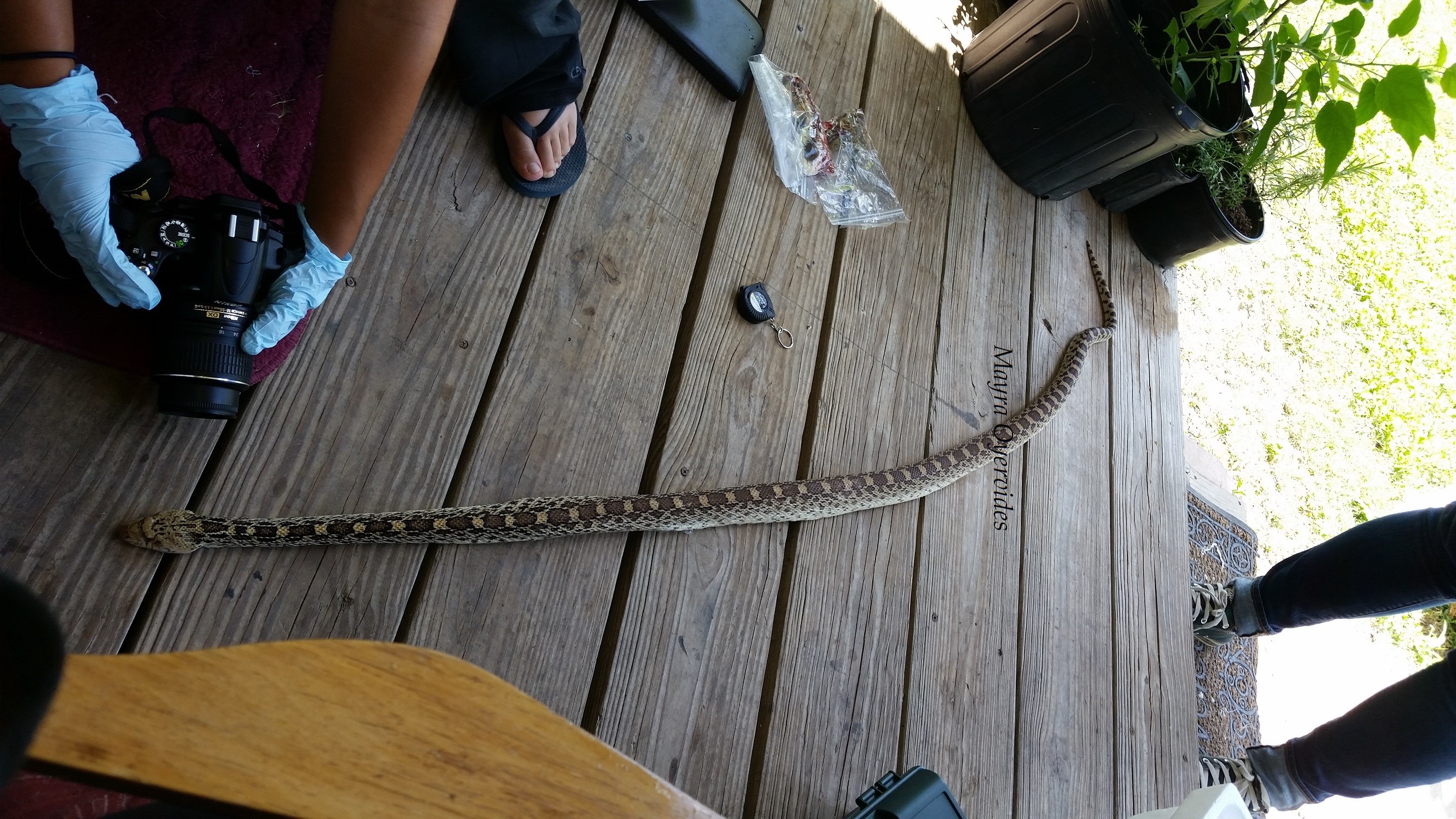
D.O.R. Bullsnake Pituophis catenifer sayiDriving down a dark county road seemingly in the middle of nowhere I stumbled upon a 7 ft Bullsnake ( Pituophis catenifer sayi) that was dead on the road (DOR). I was with my friend Bernd Skubowius at the time and we were both astonished at the size of the snake. It is unlikely the car that hit it didn’t see it, such a behemoth was visible from quite a distance. Nevertheless, because of the stigma associated with snakes people often don’t stop or go around them. On another occasion I found a gravid Gulf-Coast Ribbon snake ( Thamnophis proximus orarius) that was also a DOR, as per my usual I collected it along with several other ribbon snakes that night. I later learned, that one was of record size and the other had a record number of neonates! We published these findings to increase our knowledge of Gulf-Coast Ribbon Snakes.
Snakes fall victim to the crisscrossed death grid we call roads. Roads border every good habitat, every ranch, every preserve, roads are everywhere (but so are we).
With a growing human population and development of land there are several reasons why herps come on or near roads. For one, they have an ever increasing pressure to exit their refuge in the wild as this land is leveled and cleared for other types of development. The pressure results in wildlife emerging from these sites fleeing and seeking new patches of habitat to thrive on. Animals can continue emerging from these sites for months and months and many fall victim to mortality by the ever increasing vehicular activity. Additionally, there is a phenomenon we call the edge effect. In ecology the edge effect is particularly pronounced when the habitat is highly fragmented into ever decreasing patches. Edges and mid-disturbance levels result in higher biodiversity as it creates new microhabitats constantly. Unfortunately, the edge effect we see most as herpers is that one caused by new roads and development. Thus, we encounter a large number of DORs. It is becoming an increasing trend, at least in some areas, that road cruising results in more DORs than live snakes. It’s sad, but not all is lost!
(to be continued)
D.O.R. Texas Coral Snake Micrurus tener tener
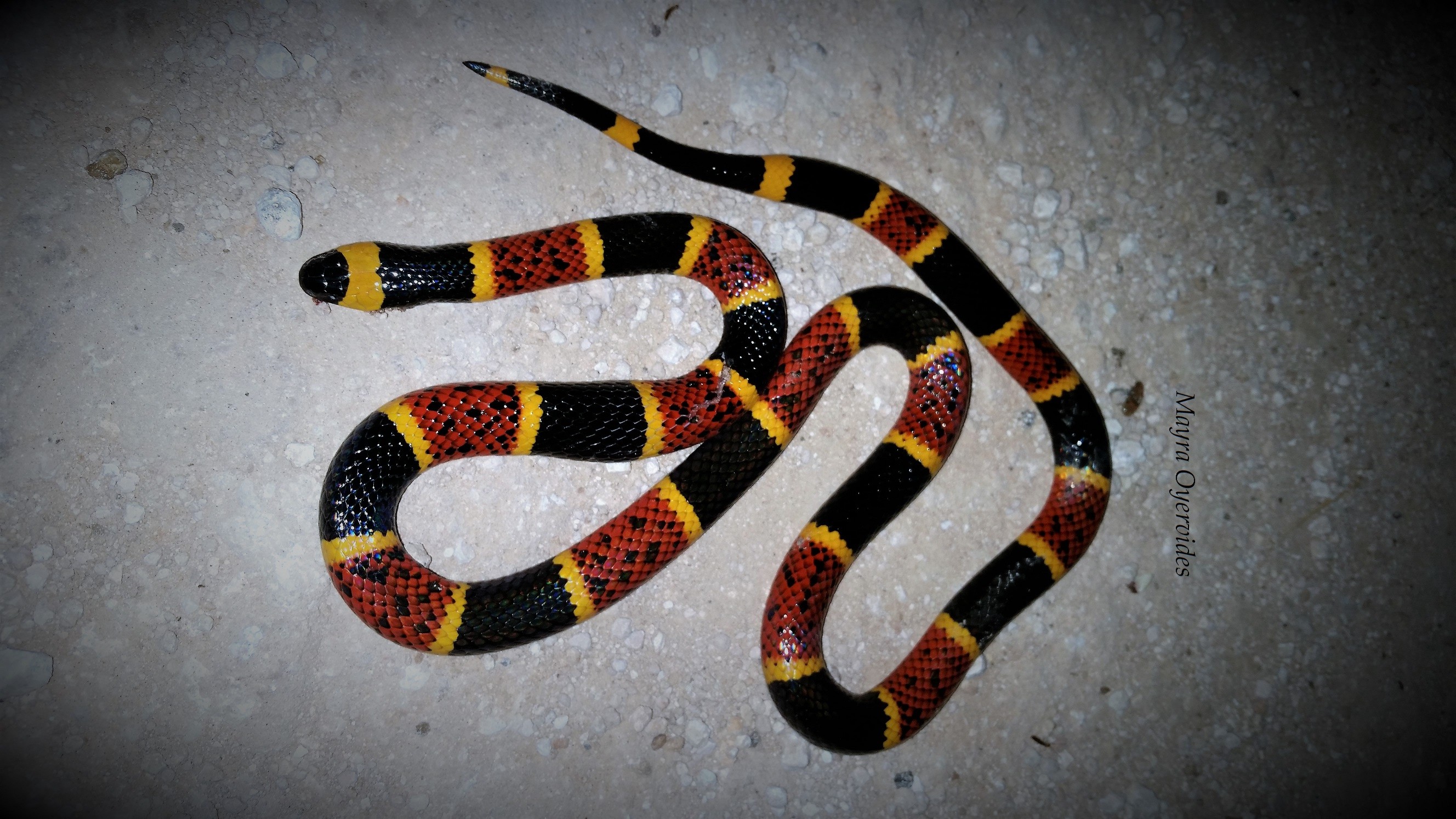
Thursday, March 2 2017
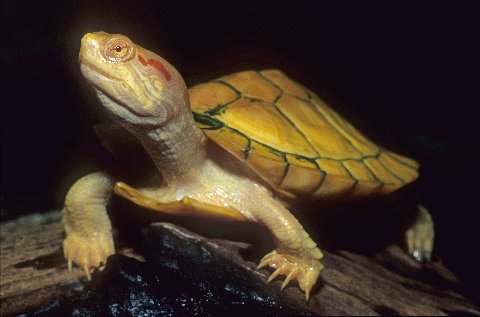
Albino red-eared sliders are now readily available in the pet trade.
The beautiful and ever popular red-eared slider, Trachemys scripta elegans, may be the most successful reptilian invader known to the world.
When I was a kid, red-eared slider hatchlings, then sold as “baby green turtles”, were available in just about every 5 and dime and pet store in the nation. Like kids in untold numbers of other households I was a keeper of these pretty chelonians. In those early days of herp-keeping-non-knowledge such inappropriate foods as dried ant pupae and caging such as plastic turtle bowls complete with an insertable plastic palm tree were the rage. And I never heard a single salesperson explain that when adult these turtles ranged from 6 to 12 inches in carapace length (try and keep those in the old style turtle bowls!), that they (like most turtles) were messy eaters, and that maintaining clean facilities was a necessary and almost daily job. The need for vitamins/calcium/full spectrum lighting was virtually unknown. It is small wonder that the majority of these turtles died. It was equally understandable why, if just by accident the red-ears happened to survive and grow, they either escaped or were eventually loosed in the nearest body of water.
Despite a regulation passed in 1975 a regulation that made it illegal to sell or barter chelonian eggs or turtles having a carapace length of less than 4” domestically except for scientific purposes turtles continued (often surreptitiously) to be sold (I was surprised to learn how many 5 and 10 year old scientists we had in this country). And thousands more continued to be exported.
Somewhere along the line feral populations of red-ears began to show up in odd places—New England, the Pacific Coastal region, the desert southwest, France, Asia, Brazil…
It seems that at least some, and from the looks of things, probably many, of the escaped and released red-ears have survived and are breeding.
Check out these statistics from the Global Invasive Species Database that document this turtle now being established in Asia, Australia, Austria, The Bahamas, Bahrain, Belgium, Bermuda, Brazil, British Virgin Islands, Cambodia, Canada, Cayman Islands, Chile, China, Costa Rica, Czech Republic, Denmark, Dominican Republic, Europe, Finland, France, French Polynesia, Germany, Gibraltar, Guadeloupe, Guam, Guyana, Hong Kong, Hungary, Indonesia, Israel, Italy, Japan, Korea, Democratic People's Republic of, Korea, Republic of, Latvia, Lithuania, Malaysia, Martinique, Micronesia, Federated States of, New Caledonia, New Zealand, Northern Mariana Islands, Panama, Philippines, Poland, Puerto Rico, Reunion, Saint Lucia, Singapore, South Africa, Spain, Sri Lanka, Sweden, Switzerland, Taiwan, Thailand, Trinidad and Tobago, United Kingdom, and Viet Nam.
Statistics such as this help undermine our hobby!
Continue reading "Definitely NOT a Stay-at-home, The Invasive Red-eared Slider"
|














